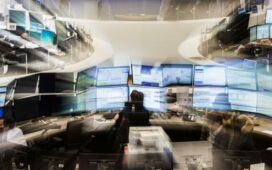Fastenal. (Photo by Jamie Squire/Getty Images for NASCAR)
Bob Kierlin, the visionary behind Fastenal, built it into a billion-dollar industry leader. For nearly a decade, he visited my classes at the Carlson School each semester, sharing his wisdom with students. Despite his success, he remained one of the humblest entrepreneurs, and greatest leaders, I’ve ever met. Students were consistently in awe of not just his achievements but also his humility. Every time I asked the class if they would want to work for him – every hand went up.
The Billion-Dollar League.
Kierlin was one of Minnesota’s greatest entrepreneurs – standing alongside post-war giants like Earl Bakken (Medtronic), Dick Schulze (Best Buy), Glen Taylor (Taylor Corporation), and Richard Burke (UnitedHealthcare). Yet, what truly set him apart wasn’t just his business acumen – it was his leadership. He never sought the spotlight or took sole credit for Fastenal’s success. Instead, he empowered those around him, proving that great leadership can transform an ordinary company into an extraordinary one.
There’s an old proverb, “Lions led by sheep will lose to sheep led by a lion.” Fastenal’s success exemplified this truth. Kierlin didn’t just build a company – he cultivated a team of leaders, and that made all the difference.
Background
When Bob Kierlin started Fastenal, it was the smallest among roughly 10,000 fastener businesses in the United States. With just $31,000 from his own savings and financing from four friends, he transformed it into the largest fastener company in America (Kierlin’s case is featured in Bootstrap to Billions at www.dileeprao.com).
Pivot if Your Initial Idea Doesn’t Fit the Market
From the age of 12, Bob Kierlin dreamed of creating a vending machine for selling nuts and bolts—so much so that he even designed one. After getting his MBA and landing a job at a major company, Kierlin was ready to chase that dream. He rented a store in his hometown of Winona, MN, and began building the vending machine. However, when locals asked about his project and he inquired if they would buy from such a machine, he quickly realized their needs didn’t align with his idea. Within days, Kierlin shifted gears, putting the vending machine on hold and opening a traditional store instead.
The lesson: When the market tells you your assumptions are wrong, don’t be afraid to pivot.
Speed: Finding the Right Growth Velocity
Entrepreneurs must determine the right growth speed for their venture at each stage. How fast can they grow? How fast should they grow? The ideal speed is influenced by factors such as industry dynamics, market demand, and financial resources.
Kierlin mastered this balance by aligning growth with customer demand, operational capacity, and cash flow. Instead of rushing expansion, he started with a single store focusing on profitability and refining his business model. Only after making some mistakes and learning the nuances of the industry did he begin scaling ensuring sustainable strategic growth rather than reckless expansion.
Financing a Unicorn without VC
Early on, Kierlin discovered that Fastenal could scale without external financing — if he adhered to key operational and financial metrics. He focused on controlling his asset needs, maintaining cash flow, and most importantly, ensured a steady pipeline of qualified managers to support expansion:
- Assets: Fastenal’s primary asset requirements were inventory and receivables for new stores. These were his only assets. He leased everything else from buildings to vehicles. He even leased garages from homeowners around his plants as he needed them. Over time, he was leasing so many pickup trucks that Ford made him an offer he could not refuse – he could buy the trucks, use them for a year, and resell them a year later at a profit – turning an expense into financial advantage.
- Cash flow: Kierlin kept his cash flow positive by carefully managing both revenue and costs. He maintained high margins by delivering exceptional value to customers while keeping expenses low through disciplined, frugal operations.
- Management: To ensure the availability of qualified leaders, Kierlin launched the Fastenal School of Management, equipping managers with the skills needed to sustain and drive the company’s growth.
The Brilliant Formula Linking Business & Finance
Most importantly, Kierlin discovered a key relationship between inventory turns, gross margins, and sustainable growth. When gross margins were 50% and inventory turned three times per year, Fastenal could grow at an annual rate of 30% without external financing.
Each year, the company calculated the average number of stores from the previous year and expanded by 30%. To maintain profitability, they set strict margin requirements based on inventory turnover:
- 3 turns per year → Minimum 50% margin.
- 2 turns per year → Minimum 60% margin.
- 4 turns per year → Minimum 40% margin
- Below 30% margin → No stock; items were direct-shipped from manufacturers.
Fastenal also aligned its management training and expansion strategy with this 30% growth rate to have sufficient number of trained managers ready to lead new stores while training store assistants to step into leadership roles at existing locations.
Applying Kierlin’s Strategy: Use with Caution
Kierlin’s approach was highly effective for Fastenal, but it won’t work in every industry. Consider these key factors before applying his strategy:
- No VC Influence: Kierlin operated in an industry—nuts and bolts—where VC was nonexistent. No VC would fund such an “unsexy” business, meaning competitors weren’t artificially boosted by external funding aimed at rapid expansion.
- Fragmented Industry Advantage: Fastenal’s early competitors were small, independent businesses. Once Fastenal reached a certain scale with multiple locations, these smaller rivals struggled to compete. If you’re in a fragmented industry, reaching a critical mass can give you a similar competitive edge. Sam Walton build Walmart in rural America with the same strategy.
- Access to Financing—But No Need for It: Fastenal’s strong cash flow and profitability meant Kierlin could have easily secured external financing. However, he never took it—because he didn’t need it. Ironically, financiers are most eager to invest in businesses that don’t require funding.
- People-First Leadership: The real key to Kierlin’s success was his unwavering focus on people and service where everyone is supplying the same product. He sought out leaders who were self-aware, cared about others, and thrived in a team environment. By nurturing a culture of growth and empowerment, he built a company that could scale sustainably.
Lessons for You
- Master Your Advantage Before Expanding: Don’t rush into growth before you’ve honed your competitive edge. Kierlin spent years refining his business model and understanding his customers with just one store before scaling.
- Prioritize Cash Flow: Strong cash flow fuels sustainable growth. The more you maximize it, the more control you have over expansion.
- Keep Costs in Check: The less financing you need, the more freedom you have. Kierlin’s disciplined cost management allowed Fastenal to scale without relying on outside capital.
- Avoid Premature Funding: Seeking financing too early can be costly. By first proving profitability and generating positive cash flow, Kierlin put himself in a position to attract funding if he ever wanted it. He didn’t.
MY TAKE: Prioritize positive cash flow, develop a smart-finance strategy, and serve your customers better than your competitors. If you’re building a big business in a so-called “commodity” industry without outside capital, you must master every other aspect—cash flow, operations, and customer experience.
Bob Kierlin proved that billion-dollar success isn’t just about funding—it’s about culture and leadership. By focusing on people, staying humble, and making disciplined financial choices, he built an empire without ever chasing the spotlight. His true legacy isn’t just Fastenal’s growth—it’s the corporate culture and leaders he nurtured along the way.
For more information on how entrepreneurs built large companies by using skills before venture capital, see “Nothing Ventured, Everything Gained: How Entrepreneurs Create, Control & Retain Wealth without Venture Capital.” (www.dileeprao.com)



